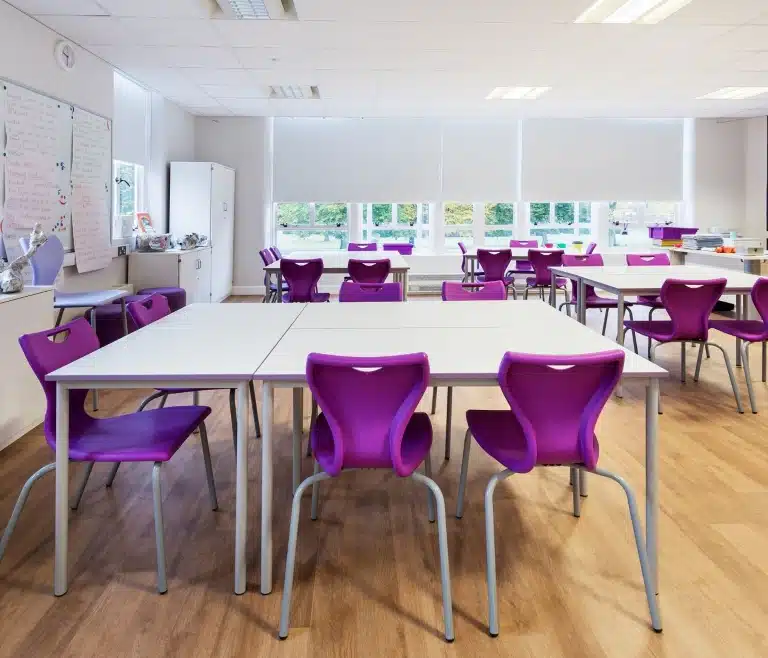Encouraging Collaborative Learning in the Classroom
Nov 7, 2023 • 5 minutes

Collaborative learning is a cornerstone of modern education, offering a dynamic environment that nurtures academic growth and equips students with vital life skills. At Westcountry Group, we understand the importance of educational interior design that promotes an engaging and collaborative learning environment.
In this blog, we will explore some of the most effective ways that educational environments can encourage collaborative learning along with the benefits.
Flexible Seating Arrangements:
The layout of the classroom greatly impacts the ability for students to work together and learn collaboratively. Conventional rows of desks often hinder interaction, whereas different seating arrangements can encourage teamwork and active participation. Assigning shared desks promotes conversation and an exchange of knowledge and ideas. Circular or hexagonal tables create an environment of equality, where everyone can easily see and engage with their peers. These setups facilitate group assignments, open discussions, and the sharing of ideas, ultimately fostering an interactive learning environment.
Purposeful Zones:
Encouraging purposeful divisions within the classroom is an effective strategy for enhancing collaborative learning experiences. By designating specific zones for distinct activities like reading spaces, discussion corners, and project areas, educators can inspire engagement with coursework in varied and dynamic ways. Reading spaces provide a tranquil atmosphere with cosy seating arrangements and ample lighting that encourage quiet contemplation and research endeavours. Discussion corners serve as platforms for group conversations and debates that foster the exchange of ideas as well as active listening skills. Project areas are equipped with necessary resources and tools that empower students to collaborate on hands-on assignments together. These carefully allocated zones not only cater to individual preferences but also ignite collaborative interactions by providing diverse opportunities to work together, share knowledge, and develop essential life skills.
Group Projects:
Collaborative learning in the classroom can be greatly enhanced through the use of group projects. By assigning tasks that necessitate teamwork towards a common objective, educators are able to cultivate a sense of cooperation. These projects enable students to combine their unique abilities, exchange knowledge, and cultivate a sense of accountability within a team setting. Group projects offer a practical and hands-on approach to education that closely resembles real-life situations, nurturing the necessary skills for future collaborative endeavours in both their academic and professional pursuits.
Resource Accessibility:
Promoting collaborative learning in the classroom heavily relies on the accessibility of resources. By providing convenient access to a diverse range of resources, including library books, computers, and digital materials, students are empowered to effectively explore and share information. These resources not only facilitate group research but also cultivate an atmosphere of collective problem-solving and idea exchange. They motivate students to actively seek information, experiment with new technologies, and collaborate in order to overcome different challenges.
Improved Communication Skills:
Collaborative learning is a potent force that boosts communication skills. A study conducted by Pearson found that a remarkable 82% of teachers strongly believe in the transformative impact of collaborative learning on communication abilities. Through group projects, discussions, and idea sharing, students cultivate the ability to express their thoughts clearly, actively listen to their peers, and adapt their communication style to various situations.
Following the Rules:
The practice of collaborative learning offers a valuable opportunity to develop the important ability of adhering to rules and guidelines. By working together in groups, students are required to follow agreed-upon procedures and codes of conduct. This fosters discipline and instils a reverence for rules, which plays a crucial role in personal and professional growth.
Leadership Development:
Engaging in collaborative learning not only encourages teamwork but also serves as a fertile environment for nurturing leadership abilities. When students participate in group projects and activities, opportunities for leadership naturally arise. They acquire skills in guiding their peers, delegating tasks effectively, and motivating the team towards a common goal. This first-hand experience empowers indispensable qualities of successful leaders such as decision-making capabilities, effective communication skills, and the ability to inspire and manage a team harmoniously. By assuming diverse roles within the group dynamic, they gain an understanding of leading by example while adapting flexibly to various situations in order to achieve objectives collectively.
Problem-Solving Skills:
When students collaborate on projects or complex tasks, they are faced with obstacles that demand creative thinking and inventive solutions. This approach prompts them to examine problems from various angles, generate ideas through brainstorming, and collectively discover successful resolutions. Collaborative learning environments foster critical thinking skills and enhance problem-solving capabilities, as individuals must navigate diverse perspectives and overcome challenges as a unified team.
Enhanced Creativity:
In collaborative settings, students are empowered to break away from conventional modes of thinking and explore new horizons of creativity. Through project collaboration, knowledge sharing, and idea generation, students unleash their creative potential and cultivate this indispensable skill.
Higher Academic Achievement:
Multiple studies have consistently demonstrated that students who participate in collaborative learning outperform their peers academically. This is because they gain valuable insights from others, are exposed to diverse perspectives, and have the chance to learn from their fellow students. The National Center for Biotechnology Information (NCBI) conducted a study that supports this finding, showing that collaborative learning has a positive impact on student achievement.
Collaborative learning is pivotal in shaping students into well-rounded individuals, preparing them for the ever-changing job market and the demands of the modern world.
Westcountry Group’s expertise in designing classrooms that promote postive learning outcomes makes us the ideal choice for educational institutions.
Contact us today to find out more – call 0330 030 0330 to discuss your project with our educational interior design team, email: sales@westcountrygroup.com or visit https://www.westcountrygroup.com/education.
Let us help you transform your classrooms into spaces that optimise learning and enhance student performance.






